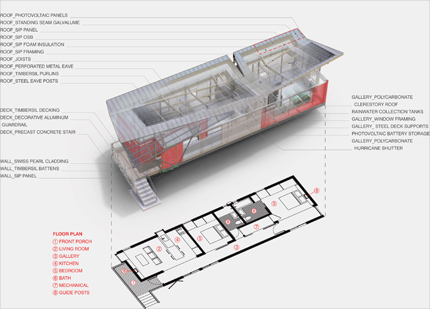
Made from prefabricated parts, the Float House will cost about $150,000
In repopulating cities hit by Hurricane Katrina’s floods, or anywhere waters rise (as they do increasingly around the world), the big question racking the brains of architects and planners has been how to keep houses high and dry when storms surge onshore. The common impulse has been to find ways to hike up the main living areas of houses to 10, 15 or 20 feet high, which is rather imposing on a dry day and costly when you consider that elevators run easily into the five digits.
But today, architects at Morphosis in Los Angeles, working with graduate architecture students at the University of California, Los Angeles, unveiled another solution: a floating house. In the Netherlands, as Morphosis principal Thom Mayne points out, the notion is not novel, yet it hasn’t really been tried in this country. Rather than design around the idea of a house as a fixture on the ground, the Morphosis/UCLA team came up with a house that can close up tight and rise like a boat does in a marina at high tide — and do so affordably.

Float House components. In the event of flooding, the structure rises on two steel guideposts (8).
The Float House, on Tennessee Street in the flood-ravaged Lower Ninth Ward, will cost about $150,000; the architects gleaned savings from prefabrication and mass production. It was designed over the past two years for Make It Right, a foundation started by the actor Brad Pitt to help rebuild New Orleans with sustainable, storm-resistant housing.
This model is not a far cry from Louisiana shotgun house. It’s a long box, sided in fiber-cement panels with a folding, photovoltaic roof. Inside, rooms range along one wall and open onto a gallery running the house’s length. Beneath the house is a modular chassis of polystyrene foam blocks encased by glass-fiber-reinforced concrete. Inside the chassis are the house’s guts — plumbing and electrical and mechanical equipment, plus rainwater collection tanks and battery packs charged by the sun. (The house is equipped to go off the grid.)
Concealed inside either end of the structure is a 12-foot-high steel guidepost, anchored by pilings driven down 45 feet. If water were to rise around the house, it would float straight upward along the guideposts and stay fastened to the site. Indeed, at first the house was too light and needed ballast. “It had too much buoyancy,” Mayne says, “so we added a topping slab to the mass of the building, like putting a lead keel on a boat.”
There were a number of code issues to work out with the local building cops, given its nonstandard systems and structure, but it eventually won their approval. Apparently, no insurance underwriter has weighed in on the design yet, but, Mayne says, “I would think they’d be elated,” because during a flood, the homeowner’s biggest investment should stay intact. Ideally, by that time, the homeowner will have closed the carbon-fiber panels over the windows and left town.
Tom Darden, executive director of Make It Right, says the house is going on the market almost immediately. “I would expect that thing to sell in 30 days or less,” he says. It will likely go to a family already enrolled in the foundation’s homebuyer counseling process.
Mayne says that whoever lives there will hardly notice the guideposts or the floatation apparatus. “I see it as a safety belt or an air bag in a car,” he says. “It doesn’t get used. And then when you need it, it gets used.”


Comments [16]
10.07.09
02:10
10.07.09
05:00
10.07.09
05:01
10.07.09
11:44
10.08.09
02:59
Given that a typical New Orleans residence in the 9th Ward, even prior to Katrina, cost significantly less that $150k, this project seems extremely unaffordable for most residents right out of the gate. This suggests a subsidy of some sort to bridge the gap.
Further, is the suggestion here that the construction costs are really in the range of $110k and a typical mark-up/oh& p are being applied, or, alternatively (and as I suspect) some heavy discounting in the true costs & omission of typical mark-ups have been applied to make this project seem in the realm of the affordable - ie more subsidies?
My point is: there is likely heavy subsidy involved in this project- explicitly so in the design effort, and just as likely in the construction & sales.
The question is: should this subsidy be applied to the protection of single family homes at the expense of larger community infrustructure?
At the most basic level: should we be building floating SFH's on detatched lots, or investing that money instead in better levies? Should we be perpetuating suburban growth in this flood-prone & impoverished area, or asking more regional questions about appropriate sites, restoring lost wetlands, and whether in the face of rising sea levels in makes sense to rebuild such a car-intensive way of life?
After all, these floaties won't help the apartments, schools, hospitals, water & sewer lines, and every other bit of infrastructure that a community needs to function, and its sort of crazy to imagine that New Orleans bounces right back after another Katrina on the back of some houseboats (hell, seal a FEMA trailer with duct tape and it probably floats).
Architects can be clever while being myopic & baldly stupid at the same time, and this represents, in a backhanded way, another form of privilege for the relatively wealthy: one can imagine the helicopter shots of a few of these things bobbing around, unmoored from their pilings, as the rest of the city is flooded & destroyed, again.
The solution to a war is not to try to make a few houses bullet-proof, and the solution to the catastrophic floods of New Orleans is not to make single family homes float. Lets stop playing with boats and focus on the serious questions about planning instead.
10.09.09
09:47
10.11.09
08:55
10.12.09
11:27
My only worry is the price tag. In the long run it seems a house like this would save lots of money on power and insurance (hopefully) but can it be afforded upfront? If enough people cannot afford it so the house can be mass produced, is it a viable solution? It also seems a bit small for larger families, but perhaps larger models can be made as well? Seems there are a lot of questions but I still think it is a great start.
10.12.09
07:25
10.13.09
12:36
10.15.09
03:46
11.10.09
10:12
As water levels rise due to the green house effect, so does ground-water levels, and when this combines with an increase in heavy rain, both in intensity and the number of times per year, a lot of 'normal' areas will experience flooding due to excessive rain water that the sewer systems cannot guide away fast enough.
Preparing for this by building larger sewer systems is extremely costly - therefore, simpler solutions are needed by the society. Large delay bassins is one way - but there is a conflict between the need for large, open areas for the bassins, and the fact that they are mostly needed in dense poulations where land is expensive and a small resource.
In this case, flood houses built INSIDE these bassins can be the perfect idea. You provide the large basins needed, but you can build or 'populate' these areas still. And since these situations a far more numerous than the extreme hurricane/flooding danger in New Orleans, this may be the kick start that's needed to create the basis for a prefab poduction on an industrial scale, that will eventually lower prices, to the benefit also for low income families in New Orleans.
11.16.09
05:58
12.01.09
07:29
05.25.10
01:19
09.07.10
11:57